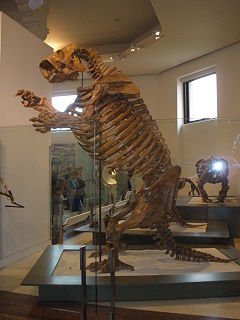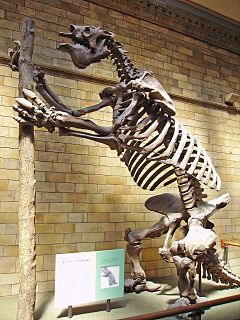 W
WDiacalymene is a genus of trilobite from the order Phacopida, suborder Calymenina. It includes the species D. ouzregui, D. clavicula, D. diademata and D. gabrielsi. It lived in the Ordovician and Silurian periods.
 W
WFavosites is an extinct genus of tabulate coral characterized by polygonal closely packed corallites. The walls between corallites are pierced by pores known as mural pores which allowed transfer of nutrients between polyps. Favosites, like many corals, thrived in warm sunlit seas, feeding by filtering microscopic plankton with their stinging tentacles and often forming part of reef complexes. The genus had a worldwide distribution from the Late Ordovician to Late Permian.
 W
WGlossotherium was a genus of ground sloth. It was a heavily built animal with a length of about 4 metres (13 ft) snout to tail-tip, a weight estimated at 1,000 kg (2,200 lb), and could potentially assume a slight bipedal stance.
 W
WGlyptodon was a genus of large, heavily armored mammals of the subfamily Glyptodontinae – relatives of armadillos – that lived during the Pleistocene epoch. It was roughly the same size and weight as a Volkswagen Beetle. With its rounded, bony shell and squat limbs, it superficially resembled a turtle, and the much earlier dinosaurian ankylosaur – providing an example of the convergent evolution of unrelated lineages into similar forms. In 2016 an analysis of Doedicurus mtDNA found it was, in fact, nested within the modern armadillos as the sister group of a clade consisting of Chlamyphorinae and Tolypeutinae. For this reason, glyptodonts and all armadillos but Dasypus were relocated to a new family, Chlamyphoridae, and glyptodonts were demoted from the former family Glyptodontidae to a subfamily.
 W
WThis is a list of gomphothere fossils found in South America. Gomphotheres were elephant-like mammals that lived from the Middle Miocene to the Holocene.
 W
WLestodon is an extinct genus of megafaunal ground sloth from South America during the Pliocene to Pleistocene periods. Its fossil remains have been found in Argentina, Paraguay, Uruguay, Venezuela, Bolivia, and Brazil. Measuring approximately 4.6 metres (15 ft) from snout to tail tip, it is estimated to have weighed 2,590 kilograms. It was a herbivore and primarily fed on the grasses on the South American plains and is thought to perhaps have used its semi-bipedal stance to obtain foliage from trees. Lestodon is placed as member of the Mylodontidae as indicated by the lobed form of the last tooth in the dentition.
 W
WMacrauchenia was a large, long-necked and long-limbed, three-toed native South American mammal in the order Litopterna. The genus gives its name to its family, the Macraucheniidae or "robust litopterns". Like other litopterns, it is not closely related to any living mammal, being most closely related to the group containing horses, rhinos and tapirs, from which litopterns diverged approximately 66 million years ago. The oldest fossils in the genus date to the late Miocene, around seven million years ago, and M. patachonica disappears from the fossil record during the late Pleistocene, around 20,000-10,000 years ago. M. patachonica is one of the last and best known member of the family and is known primarily from the Luján Formation in Argentina, but is known from localities across southern South America. Another genus of macraucheniid Xenorhinotherium was present in northeast Brazil and Venezuela during the Late Pleistocene. The type specimen was discovered by Charles Darwin during the voyage of the Beagle. In life, Macrauchenia may have resembled a humpless camel, though the two taxa are not closely related. It fed on plants in a variety of environments across what is now South America. Among the species described, M. patachonica and M. ullomensis are considered valid; M. boliviensis is considered a nomen dubium; and M. antiqua has been moved to the genus Promacrauchenia.
 W
WMegatherium is an extinct genus of ground sloths endemic to South America that lived from the Early Pliocene through the end of the Pleistocene. It is best known for the elephant-sized type species M. americanum, sometimes called the giant ground sloth, or the megathere, native to the Pampas through southern Bolivia during the Pleistocene. Various other smaller species belonging to the subgenus Pseudomegatherium are known from the Andes. Megatherium is part of the sloth family Megatheriidae, which also includes the similarly elephantine Eremotherium, which was native to tropical South America and southern North America. Only a few other land mammals equaled or exceeded M. americanum in size, such as large proboscideans and the giant rhinoceros Paraceratherium. Megatherium was first discovered in 1788 on the bank of the Luján River in Argentina. The holotype specimen was then shipped to Spain the following year wherein it caught the attention of the esteemed paleontologist Georges Cuvier, who was the first to determine, by means of comparative anatomy, that Megatherium was a sloth. Megatherium became extinct around 12,000 years ago during the Quaternary extinction event, which also claimed most other large mammals in the New World. The extinction coincides with the settlement of the Americas, and a kill site where a M. americanum was slaughtered and butchered is known, suggesting that hunting could have caused its extinction.
 W
WPanochthus is an extinct genus of glyptodont, which lived in the Gran Chaco-Pampean region of Argentina, Brazil, Bolivia, Paraguay and Uruguay during the Pleistocene epoch.
 W
WScelidotherium is an extinct genus of ground sloth of the family Scelidotheriidae, endemic to South America during the Late Pleistocene epoch. It lived from 780,000—11,000 years ago, existing for approximately 0.67 million years .
 W
WStereosternum tumidum is an extinct genus of mesosaur marine reptile from the Early Permian of Brazil and also the Great Karoo Basin of South Africa. The taxon mesosaur is a monophyletic group containing Brazilosaurus sanpauloensis and Mesosaurus tenuidens.
 W
WToxodon is an extinct genus of South American mammals from the Late Miocene to early Holocene epochs. It is a member of Notoungulata, one of several now extinct orders of hoofed mammals indigenous to South America. It was among the largest and last members of its order, and was probably the most common large hoofed mammal in South America of its time.